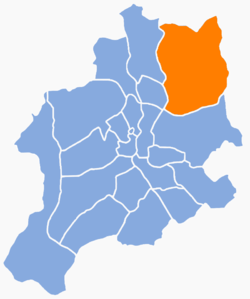Hałcnów
Hałcnów is an osiedle (district) of Bielsko-Biała, Silesian Voivodeship, southern Poland. It is located in the north-east part of the city. It was a separate municipality, but was merged into Bielsko-Biała in 1977. The osiedle has an area of 13.5091 km2 and on December 31, 2006 had 7,747 inhabitants.[1]
Hałcnów | |
|---|---|
 Aerial view of Hałcnów | |
 Location of Hałcnów within Bielsko-Biała | |
| Coordinates: 49°50′59″N 19°05′31″E | |
| Country | |
| Voivodeship | Silesian |
| County/City | Bielsko-Biała |
| Area | |
| • Total | 13.5091 km2 (5.2159 sq mi) |
| Population (2006) | |
| • Total | 7,747 |
| • Density | 570/km2 (1,500/sq mi) |
| Time zone | UTC+1 (CET) |
| • Summer (DST) | UTC+2 (CEST) |
| Area code(s) | (+48) 033 |
History
The village was first mentioned in 1404.[2] Politically the village belonged then to the Duchy of Oświęcim, a fee of the Kingdom of Bohemia. In 1457 Jan IV of Oświęcim agreed to sell the duchy to the Polish Crown, and in the accompanying document issued on 21 February the village was mentioned as Halcznow.[3] The territory of the Duchy of Oświęcim was eventually incorporated into Poland in 1564 and formed Silesian County of Kraków Voivodeship.
Upon the First Partition of Poland in 1772 it became part of the Austrian Kingdom of Galicia. In that time it used to be known in German language as Alzen, Alzenau, as it was a part of a German language island around Bielsko (German: Bielitz-Bialaer Sprachinsel).[4] In 1786 the village became a seat of a Catholic parish.
According to the Austrian census of 1900 the village had 2669 inhabitants living in 288 houses. The census asked people their native language, and results show that 1986 (74,4%) were German-speaking and 678 (25,4%) were Polish-speaking. The dominant religious groups were Roman Catholics with 2652 (99,4%), 11 (0,4%) Jews and 6 persons were adherents of another religion.[5] A specific Germanic ethnolect was also spoken here.[4]
After World War I and fall of Austria-Hungary it became part of Poland. It was annexed by Nazi Germany at the beginning of World War II, and afterwards it was restored to Poland. The local German-speaking population fled or was expelled.
See also
References
- Rada Miejska w Bielsku-Białej (21 December 2007). "Program rewitalizacji obszarów miejskich w Bielsku-Białej na lata 2007–2013" (PDF) (in Polish). pp. 9–10. Archived from the original (PDF) on 22 May 2015. Retrieved 21 May 2015.
- Panic, Idzi, ed. (2011). "Zaplecze osadnicze Bielska". Bielsko-Biała. Monografia miasta (in Polish). Tom I: Bielsko od zarania do wybuchu wojen śląskich. Bielsko-Biała: Wydział Kultury i Sztuki Urzędu Miejskiego w Bielsku-Białej. p. 213. ISBN 978-83-60136-31-7.
- Prokop, Krzysztof Rafał (2002). Księstwa oświęcimskie i zatorskie wobec Korony Polskiej w latach 1438-1513. Dzieje polityczne (in Polish). Kraków: PAU. p. 151. ISBN 83-88857-31-2.
- "hałcnowski i bielsko-bialska wyspa językowa". inne-jezyki.amu.edu.p (in Polish). Dziedzictwo językowe Rzeczypospolitej. 2014. Archived from the original on 6 October 2014. Retrieved 12 September 2014.
- Ludwig Patryn (ed): Gemeindelexikon der im Reichsrate vertretenen Königreiche und Länder, bearbeitet auf Grund der Ergebnisse der Volkszählung vom 31. Dezember 1900, XII. Galizien, Wien 1907.